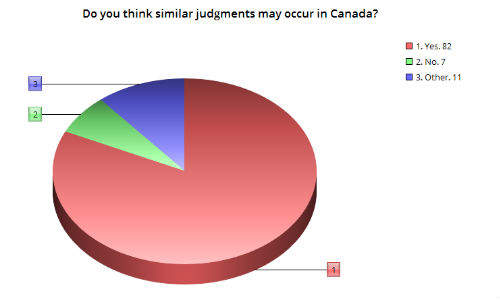By Mike Davey
Hamilton, Ontario — October 17, 2017 — The need to follow OEM procedures has been mentioned by numerous industry figures and OEM position statements, but the recent verdict against John Eagle Collision Centre in Texas has thrown the situation into stark relief. In brief, the facility did not follow OEM procedure when it repaired a 2010 Honda Fit. The couple who later purchased the vehicle were severely injured in a subsequent crash. You can read more about this case here, but the final result is that the facility was ruled to be at least partially responsible, and ordered to pay millions in damages.
Collision Repair magazine’s latest survey asked our readers to weigh in on the subject of liability in repairs. First, we asked them if they thought similar judgments could occur in Canada. The majority (82 percent) see no reason to assume that shops in Canada are safe from this sort of legal action. However, 7 percent of respondents said “No” and a further 11 percent indicated “Other.” Let’s dig into some of those a bit.
Broadly speaking, the “Other” respondents aren’t entirely sure if something like this could happen here. A shop on the hook for an “improper” repair? There’s no doubt that could happen, but damages and penalties are often seen as much higher in the US than in Canada.
It’s worth noting that John Eagle Collision Center’s website said it used “OEM procedures or better” when performing repairs. While the official Honda procedure called for welding the Fit’s roof, the shop used glue. Testimony from the shop’s production manager indicated that they did in fact think this was a superior procedure. One comment left on this question refers to this. As always, comments are presented anonymously, with only minimal editing from us.
“I have so many questions about this story it’s hard to put them all in this comments box. There is no debate they didn’t follow OEM procedures, but would that have made a difference in the accident? Are OEM procedures really the best because they have been tested, or is it just easier and cheaper to build it that way on an assembly line? Should a shop really be 75 percent responsible after somebody hydroplanes into oncoming traffic at 75 miles per hour?”
Two comments sum up the general feelings of the “No” side:
“Litigation laws in Canada are much different.”
“The dollar amount is typical American craziness. Does the shop have liability in the case? Yes, but so does the insurance company. In Canada we have to look at what is acceptable for one manufacturer and is not for another. There is no standard repair procedure for all makes and models and access to information could improve to a much higher level than it currently is.”
We also asked readers to let us know if they carried liability insurance to protect their business from events such as this. Most respondents do (78 percent), but 22 percent do not. However, comments left on this question made it clear that even those that do would not be likely to have their insurance cover a judgment of this size.
The next question asked readers to let us know if they’ve ever consulted legal counsel regarding repair liability. The majority (44 percent) have not, but a further 31 percent say they intend to. A total of 25 percent of respondents have consulted legal counsel. Of those respondents, 36 percent have consulted counsel as a direct result of this particular case.
Finally, we asked readers to let us know the best ways for a shop to protect itself from liability. For this question, respondents were asked to weight various options according to importance. You can see the totaled results in the table below.
 |
|
|
Readers weigh in on the best ways for a shop to protect itself against liability. |
Collision Repair magazine’s next survey looks at the growth of artificial intelligence in the estimating process. Will we see a day when computers replace human estimators? Take the survey at this link and let us know!












































































